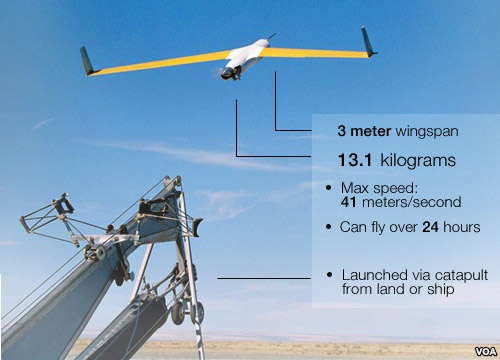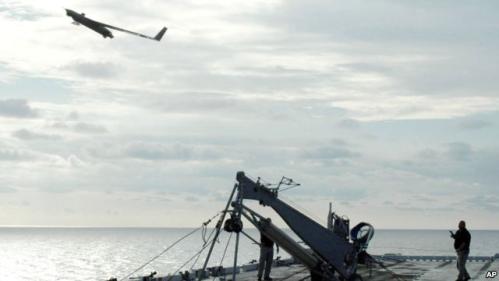
This is the second alleged U.S. spy drone Iranian officials say they have captured.

A Scan Eagle unmanned aerial vehicle launches from the flight deck of an amphibious assault ship. (File)
Dec 04, 2012 WASHINGTON — The U.S. government is disputing Iran's claims that it has captured an American spy drone in its airspace over the Persian Gulf.
Iranian state television showed images Tuesday of uniformed officers examining what Tehran claims is a U.S. intelligence drone it recently captured in its airspace.
In the background of the video is a map showing the Persian Gulf region with the words "we shall trample on the U.S." printed over it.
A U.S. Navy Central Command spokeswoman says that its drones only operate in international airspace and that none of them is missing in the region. White House officials also said they do not have any evidence that Iran's claims are true.
A year ago, the Iranian government released video showing a more sophisticated RQ-170 Sentinel that Iranians said they brought down over the eastern part of the country. This time, they say, they have the ScanEagle, a smaller drone that weighs less than 20 kilograms, has a wingspan of only three meters and usually is outfitted with a camera.
????Caitlin Lee is a military aviation correspondent for the IHS Jane's Information Group. She says several countries possess the ScanEagle, so it is possible that it might not be U.S.-operated. However, Lee does not believe possessing it has much technological value for Tehran.
"The ScanEagle, compared to the RQ-170, the ScanEagle is, I don't want to say less sophisticated, but it doesn't have some of the same features. So the ScanEagle has been around for a while, it doesn't have stealth characteristics and it's a little bit more of a simple airframe," she said.
Justin Logan is the director of foreign policy studies at the CATO Institute. He says Iran's value for the drone is more for psychological warfare, especially with Tehran claiming that it is Washington's.
"Obviously, the Iranian economy is in a bad place, so they always want to highlight the external enemy to shore up their legitimacy, so they can say, 'We're successfully defending Iranian sovereignty, Iranian airspace.' They can try to send a signal to those flying drones near or conceivably even in Iranian airspace, that they are capable of bringing one down," he said.
Logan says this type of military action is not extreme enough to be considered an act of war.
"The drone is comparatively low risk because you're not putting a pilot's life at risk, you're not putting as much cost at risk. But the flip side of that low cost is that there's a low cost for those who would seek to interdict drones. If the Iranians were to shoot down an American drone, it would be something fundamentally different than shooting down an American-manned aircraft," he said.
Last month, the Pentagon said one of its drones came under Iranian fire in the Persian Gulf, but did not suffer any damage.
Iran is at odds with the West as it is under strict international sanctions and closely watched regarding its controversial nuclear program. Western powers suspect Iran is trying to develop nuclear weapons, while Tehran insists its nuclear program is for peaceful purposes.